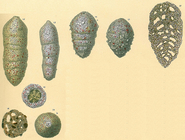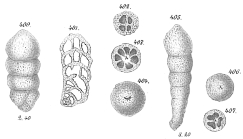Foraminifera taxon details
Liebusella Cushman, 1933
112365 (urn:lsid:marinespecies.org:taxname:112365)
accepted
Genus
Lituola nautiloides var. soldanii Jones & Parker, 1860 accepted as Liebusella soldanii (Jones & Parker, 1860) (type by original designation)
- Species Liebusella arenosa Hofker, 1983 †
- Species Liebusella baitoensis Bermúdez, 1949 †
- Species Liebusella baylesi Coryell & Embich, 1937 †
- Species Liebusella byramensis (Cushman, 1922) †
- Species Liebusella dubia (d'Orbigny, 1826)
- Species Liebusella eleganta Hofker, 1983 †
- Species Liebusella eocaena (Gümbel, 1870) †
- Species Liebusella exigua Todd & Post, 1954 †
- Species Liebusella goesi Höglund, 1947
- Species Liebusella improcera Loeblich & Tappan, 1994
- Species Liebusella intermedia (van den Broeck, 1876)
- Species Liebusella krishna Govindan, 2004 †
- Species Liebusella laevigata Voloshinova, 1970 †
- Species Liebusella scabra Kacharava, 1982 †
- Species Liebusella soldanii (Jones & Parker, 1860)
- Species Liebusella antipodum (Stache, 1864) † accepted as Arenodosaria antipodum (Stache, 1864) † (unaccepted > superseded combination)
- Species Liebusella bradyi (Cushman, 1911) accepted as Cylindroclavulina bradyi (Cushman, 1911)
- Species Liebusella hantkeni Cushman, 1936 † accepted as Clavulina rudislosta Hantken, 1889 † accepted as Cylindroclavulina rudislosta (Hantken, 1889) † (unaccepted > junior objective synonym, New name pro C. cylindrica Hantken (not d'Orbigny) already replaced.)
- Species Liebusella jamaicensis (Cushman & Jarvis, 1931) † accepted as Verseyella jamaicensis (Cushman & Jarvis, 1931) † (unaccepted > superseded combination)
- Species Liebusella pozonensis Cushman & Renz, 1941 † accepted as Alveovalvulinella pozonensis (Cushman & Renz, 1941) † (Type species of Alveovalvulinella)
- Species Liebusella rudis (Costa, 1855) † accepted as Cylindroclavulina rudis (Costa, 1855) † (unaccepted > superseded combination)
marine, brackish, fresh, terrestrial
recent + fossil
feminine
Cushman, J. A. (1933). Some new foraminiferal genera. <em>Contributions from the Cushman laboratory for foraminiferal research.</em> 9(2): 32-38., available online at https://cushmanfoundation.allenpress.com/Portals/_default/files/pubarchive/cclfr/9cclfr2.pdf
page(s): p. 36 [details] Available for editors [request]
[request]
page(s): p. 36 [details] Available for editors
Hayward, B.W.; Le Coze, F.; Vachard, D.; Gross, O. (2024). World Foraminifera Database. Liebusella Cushman, 1933. Accessed at: https://www.marinespecies.org/foraminifera/aphia.php?p=taxdetails&id=112365 on 2024-04-18
Date
action
by
2004-12-21 15:54:05Z
created
db_admin
2006-09-22 06:50:38Z
changed
Martinez, Olga
original description
Cushman, J. A. (1933). Some new foraminiferal genera. <em>Contributions from the Cushman laboratory for foraminiferal research.</em> 9(2): 32-38., available online at https://cushmanfoundation.allenpress.com/Portals/_default/files/pubarchive/cclfr/9cclfr2.pdf
page(s): p. 36 [details] Available for editors [request]
[request]
basis of record Integrated Taxonomic Information System (ITIS). , available online at http://www.itis.gov [details]
additional source Neave, Sheffield Airey. (1939-1996). Nomenclator Zoologicus vol. 1-10 Online. <em>[Online Nomenclator Zoologicus at Checklistbank. Ubio link has gone].</em> , available online at https://www.checklistbank.org/dataset/126539/about [details]
page(s): p. 36 [details] Available for editors
basis of record Integrated Taxonomic Information System (ITIS). , available online at http://www.itis.gov [details]
additional source Neave, Sheffield Airey. (1939-1996). Nomenclator Zoologicus vol. 1-10 Online. <em>[Online Nomenclator Zoologicus at Checklistbank. Ubio link has gone].</em> , available online at https://www.checklistbank.org/dataset/126539/about [details]
From editor or global species database
Diagnosis Test large, up to 5.5 mm in length, stout, with early trochospiral coil of four to five chambers per whorl, rapidly reducing to uniserial in the adult, chambers slightly inflated, somewhat overlapping previous chambers so that final chamber appears subconical, and previous chambers appear relatively short from the exterior, interior subdivided by vertical partitions projecting inward from the outer wall nearly but not quite to the center of the test, and extending from chamber floor to roof, sutures depressed; wall agglutinated, thick, commonly with calcareous particles in a considerable amount of light gray cement, and with occasional darker grains, surface smoothly finished; aperture terminal, slightly produced, commonly of one or more irregular, X-or V-shaped slits, and may have up to five separate small openings, or these may be connected in part to result in a triradiate or multiradiate opening. Eocene to Holocene; Europe; North America; West Indies; Pacific Ocean. (Loeblich & Tappan, 1987, Foraminiferal Genera and Their Classification) [details]
From editor or global species database
Image from synonym

